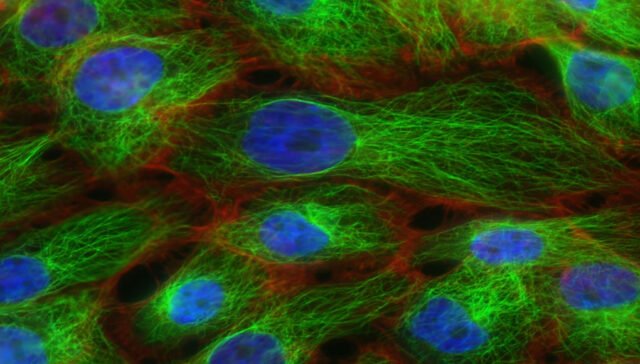Chapter Overview
This chapter explores the basic building block of all living organisms – the cell. It provides insights into cell structure, functions, types, and the processes vital to its functioning.
Key Topics Covered
- Introduction to Cells
- Definition of a cell
- Discovery of the cell (Robert Hooke)
- Cell theory (Schleiden, Schwann, and Virchow)
- Cell Structure and Components
- Cell Membrane: Structure and function, semi-permeable nature
- Cell Wall: Found in plant cells, composition, and role
- Cytoplasm: Gel-like substance containing organelles
- Cell Organelles
- Nucleus: Control center, nuclear membrane, nucleoplasm, chromosomes
- Mitochondria: Powerhouse of the cell, site of cellular respiration
- Endoplasmic Reticulum (ER): Rough and smooth ER, functions in protein and lipid synthesis
- Golgi Apparatus: Packaging and transport of molecules
- Lysosomes: Suicide bags, role in digestion
- Plastids: Chloroplasts, chromoplasts, and leucoplasts in plant cells
- Vacuoles: Storage sacs
- Ribosomes: Protein synthesis
- Types of Cells
- Prokaryotic and eukaryotic cells: Differences and examples
- Plant and animal cells: Differences in structure and function
- Processes of the Cell
- Diffusion and osmosis
- Active and passive transport
- Endocytosis and exocytosis
- Cell Division
- Mitosis and meiosis: Processes and significance
Important Highlights
Discovery and Cell Theory
- Robert Hooke first observed cells in a cork in 1665.
- Cell theory states:
- All living organisms are composed of cells.
- The cell is the basic unit of life.
- All cells arise from pre-existing cells.
Organelles and Their Functions
- Nucleus controls cellular activities and contains genetic material.
- Mitochondria generate energy in the form of ATP.
- Chloroplasts in plant cells perform photosynthesis.
Cell Transport Mechanisms
- Diffusion: Movement of substances from higher to lower concentration.
- Osmosis: Movement of water through a semi-permeable membrane.
- Active transport requires energy to move substances against a concentration gradient.
Short Questions and Answers
Q1: Who discovered the cell, and when?
A1: Robert Hooke discovered the cell in 1665.
Q2: What is the cell theory?
A2: Cell theory states that all living organisms are composed of cells, the cell is the basic unit of life, and all cells arise from pre-existing cells.
Q3: What is the function of mitochondria?
A3: Mitochondria generate energy in the form of ATP through cellular respiration.
Q4: Define osmosis.
A4: Osmosis is the movement of water molecules through a semi-permeable membrane from a region of higher water concentration to lower water concentration.
Q5: What are lysosomes? Why are they called suicide bags?
A5: Lysosomes are organelles containing digestive enzymes. They are called suicide bags because they can digest the cell’s own contents if the cell is damaged.
Multiple Choice Questions (MCQs)
Q1: Who proposed that all cells arise from pre-existing cells?
a) Robert Hooke
b) Rudolf Virchow
c) Schleiden
d) Schwann
Answer: b) Rudolf Virchow
Q2: Which organelle is known as the powerhouse of the cell?
a) Nucleus
b) Mitochondria
c) Ribosome
d) Golgi apparatus
Answer: b) Mitochondria
Q3: What is the primary function of ribosomes?
a) Protein synthesis
b) Lipid synthesis
c) Energy production
d) Transport of molecules
Answer: a) Protein synthesis
Q4: The cell wall is absent in:
a) Plant cells
b) Animal cells
c) Fungi
d) Bacteria
Answer: b) Animal cells
Q5: Which of the following is a semi-permeable structure?
a) Cell wall
b) Cell membrane
c) Nucleus
d) Mitochondria
Answer: b) Cell membrane
Q6: What is the function of chloroplasts?
a) Respiration
b) Photosynthesis
c) Protein synthesis
d) Storage of waste
Answer: b) Photosynthesis
Q7: Which type of cell has no nucleus?
a) Prokaryotic
b) Eukaryotic
c) Plant
d) Animal
Answer: a) Prokaryotic
Q8: The basic unit of life is:
a) Tissue
b) Organ
c) Cell
d) Organism
Answer: c) Cell
Q9: The term ‘protoplasm’ was coined by:
a) Robert Hooke
b) J.E. Purkinje
c) Leeuwenhoek
d) Schwann
Answer: b) J.E. Purkinje
Q10: The largest organelle in a cell is:
a) Nucleus
b) Mitochondria
c) Golgi apparatus
d) Vacuole
Answer: a) Nucleus
Conclusion
Understanding the fundamental unit of life, the cell, lays the groundwork for exploring biology and its applications. This chapter emphasizes the structural and functional intricacies of cells and highlights their role as the building blocks of all living organisms. Mastery of this topic is crucial for further studies in biology and related sciences.














Howdy just wanted to give you a quick heads up. The text in your post seem to be running off the screen in Chrome. I’m not sure if this is a format issue or something to do with browser compatibility but I thought I’d post to let you know. The design and style look great though! Hope you get the issue fixed soon. Kudos